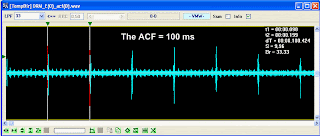CROWD-36(SERDOLIK) - OFDM mode
Ch-34, Br-40, Sh-40, PSK-4, The OFDM without CP
Author: SergUA6
Band Width ~1400 Hz
Baud Rate 40 Hz
n-Ary (PSK/MPSK) PSK-4
Count of Carriers 34
Step between carriers 40 Hz
Pilot tone(s) 393 Hz, this tone or pilot, or continue transmit data of zero in PSK-4 mode
RX mode SSB
Sonograms:
pic.1 General view
pic.2 Manipulation speed
pic.3 Detalization of the second channel
Diagrams:
pic.4 The first channel in the fourth degree
pic.5 Constellation of the first channel
CROWD-36 (SERDOLIK) - OFDM mode - is curious enough signal, where the principles of OFDM technologies usage for formation of a various type of manipulations/modulations are perfectly shown.
MFSK and OFDM segments are generated/formed absolutely equally, the difference is only in the form of used modulation, besides this OFDM signal has no cyclical prefix. Speed of manipulation is precisely equal to frequency space (step between frequencies) - that is the big rarity, and it is possibly linked with the fact, that initial synchronization is provided on the operation stage in MFSK a mode.
The presence of pilot-tone or the continuous transmission of zero in PSK-4 mode is viewed In the second channel of OFDM segment, alghough i can't say definitely.
Though OFDM signals without CP are very difficult for the analysis, in this record it is even possible to define a manipulation mode in the first (lower) channel thus this channel is rather easily possible to select/mark this channel confidently enough, thanking presence of the pilot-tone in the second channel.
Absence of the prefix allows to use as much as possible densely all the spectrum, with the maximum real speed that in this signal makes 34*40*2=2720 bps. If the second channel is really the pilot, then the maximum technical speed is slightly less - 2640 bps.























